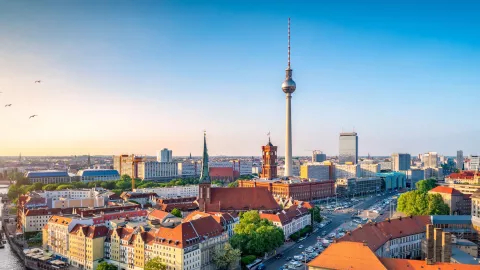

Poland
About the EURES Member
Few facts about Poland
1) Official Language: Polish
2) Location: Central Europe. Poland borders Germany, the Czech Republic, Slovakia, Ukraine, Belarus, Lithuania and Russia (the Kaliningrad exclave). Its northern border (440 km long) runs along the Baltic Sea coast.
3) Capital city: Warszawa
4) Government type: republic
5) Language: Polish
6) Population: 38 million. Poland has the seventh-largest population in Europe (omitting Russia), and the sixth-largest in the European Union.
7) Climate: The Polish climate is moderate continental, with relatively cold winters (from December to March) and hot summers
8) Currency: 1 zloty (PLN) = 100 groszy
Please find below information about living and working conditions in Poland:
https://eures.praca.gov.pl/zal/zycie_i_praca_w_polsce/polska-ang.pdf (EN)
https://eures.praca.gov.pl/zal/zycie_i_praca_w_polsce/polska-pl.pdf (PL)
Useful links:
Accommodation:
https://rentflatpoland.com https://www.olx.pl/nieruchomosci/mieszkania/ https://rentola.pl/en https://pepehousing.com https://www.nieruchomosci-online.pl/wynajem/
https://www.airbnb.pl https://otodom.pl http://www.hostels.com/ http://www.nocowanie.pl http://www.hostele24.pl
Public transport: https://www.pkp.pl/ https://www.intercity.pl/en/ https://www.metro.waw.pl/
European EURES website: https://ec.europa.eu/eures/public/language-selection
Polish EURES website: https://eures.praca.gov.pl/
National Labour Inspectorate: https://www.pip.gov.pl/pl/informacje-dla-obcokrajowcow
PESEL Number for foreigners „Universal Electronic System for Registration of the Population”: https://www.gov.pl/web/gov/uzyskaj-numer-pesel-dla-cudzoziemcow
Regulated proffessions database: https://ec.europa.eu/growth/tools-databases/regprof/index.cfm
European Health Insruance Card: https://ec.europa.eu/social/main.jsp?catId=559
Social Security Institutions in the EU member states: https://ec.europa.eu/social/social-security-directory/pai/select-country/language/en
Portal for Polish migrants: https://powroty.gov.pl
Information for foreginers: https://migrant.poznan.uw.gov.pl/en
Coronavirus - information and recommendations:
www.gov.pl/web/coronavirus/travel
According to the Statistics Poland's labour demand survey carried out among entities employing at least one person, 470 400 new jobs were created in Poland in 2020, the majority of which were jobs in the private sector (90,5%). Most new jobs were created in the smallest enterprises, employing up to nine persons (39.1%), and the least in enterprises employing more than 49 persons (28.3%). The average number of vacancies in Poland in 2020 was 83 400, that is 41.3% less than in 2019. The largest number of vacancies in 2020 was recorded at the end of the third quarter – 91 100, and the lowest number of vacancies was recorded at the end of the first quarter – 76 500.
On average, most of the vacancies in 2020 were available in the following sections of PKD (Polish Classification of Activities): manufacturing (19 900, i.e. 22.9% of available vacancies), trade and repair of motor vehicles (12 200, i.e. 14.6%), and construction (10 500, i.e. 12.6%).
The above survey shows that most vacancies in 2020 were recorded in the following occupational groups: professionals (approx. 23,6%), craft and related trades workers (approx. 22.5%), plant and machine operators and assemblers (approx. 15.7%), clerical support workers (9.5%), service and sales workers (9.4%), and technicians and associate professionals (approx. 8.7%). The labour demand survey shows that in 2020 only about 14% of vacancies were notified to labour offices, with 26% of vacancies being notified in the education section, more than 21% in the construction section, and only 1.4% in the information and communication section.
According to reports drafted by labour offices, the highest numbers of job vacancies and places of professional activation notified to labour offices in 2020 were available in the following PKD (Polish Classification of Activities) sections:
Administrative and support service activities – 316 000 job offers;
Manufacturing – 245 500 job offers;
Construction – 102 500 job offers;
Wholesale and retail trade; repair of motor vehicles, including motorcycles – 98 800 job offers;
Transportation and storage – 59 100 job offers.
In 2020, the highest numbers of job vacancies and places of professional activation notified to labour offices were recorded for the following occupations:
other manufacturing labourers – 58 300 job offers;
other elementary workers not elsewhere classified – 52 300 job offers;
hand packer – 49 500 job offers;
stock clerk – 42 100 job offers;
building caretaker – 31 100 job offers;
building construction labourer – 31 100 job offers;
warehouse worker – 29 500 job offers;
processing industry labourer – 23 100 job offers;
sales worker – 22 500 job offers;
other cleaning workers not elsewhere classified – 19 400 job offers.
Based on the Occupational Barometer survey commissioned by the Minister of Development, Labour and Technology, carried out in all districts, 29 shortage occupations were identified in 2021 at the national level.
Among shortage occupations there were among others:
9 building occupations: concrete placers and finishers, pavers, carpenters and joiners, construction roofers and sheet-metal workers, construction installation assemblers, bricklayers and plasterers, earthmoving plant operators and mechanics, building finishers and building workers;
6 manufacturing occupations: electricians, electrical equipment repairers and installers, tailors and garment workers, metalworking machine operators, wood treaters and cabinet makers, welders, toolmakers;
5 medical and care industry occupations: physiotherapists and massage therapists, medical doctors, carers of older persons or persons with disabilities, nurses and midwives, ambulance workers;
3 TSL (transport, shipping, logistics) occupations – bus drivers, heavy truck and semi-trailer truck drivers and stock clerks;
food industry and food service industry occupations: cooks, bakers;
educational occupations: vocational training teachers, teachers of vocational subjects;
occupations of other categories – motor vehicle mechanics and repairers, independent accountants.
138 occupations were considered balanced at the national level. The following previously shortage groups became balanced: automotive sheet-metal workers and spray painters and varnishers, hairdressers, and accounting and bookkeeping clerks. Ambulance workers, on the other hand, will become a shortage group in 2021.
A balanced and stable situation on the labour market in 2021 may be observed, first and foremost, in the case of: postal workers (balance forecast in 363 of 380 districts), leisure and sports trainers (balance forecast in 360 districts with local surpluses forecast in 10 districts), veterinarians and insurance agents (in both cases balance is forecast in 359 districts).
The fact that a given occupational group remains a shortage group or remains balanced on the labour market at the national level does not mean that the same trend can be observed in all provinces. The situation in this respect varies from one region to another.
Due to the low unemployment rate in 2022, no occupations have been identified as job surpluses.
Shortage occupation, does means that there are not enough resident workers to fill the available jobs in that particular sector.
In June 2022 Poland still had one of the lowest unemployment rate in the EU, at the level 4.9%.
Representatives of deficit professions usually do not have any difficulties in finding employment - they can easily choose from the job vacancies of various employers. In 2022 there are 30 professions in Poland with a deficit status – as follow from "Professions Barometer 2022" report. The labour market shortages are among others electricians, locksmiths and cooks, but also employees of the medical service. Many employers are unsuccessfully looking for their representatives!
On other hand in 2022 there are no surplus sectors where we can identify job surpluses, so it means that you can find easily job in other sectors as well.
What kind of employees are missing in Poland?
In 2022 the most shortages occurred in the construction and medical care industries. You can check full list below and it’s includes the following professions:
construction industry: concrete mixers and fixers, pavers, carpenters and construction carpenters, roofers and tinsmiths, construction installation fitters, bricklayers and plasterers, heavy equipment operators and mechanics, construction finishing workers, construction workers,
medical and care industry: physiotherapists and masseurs, doctors, healthcare assistants, nurses and midwives, paramedics, psychologists and psychotherapists,
manufacturing industry: electricians, electromechanics and electricians, machine tool operators, woodworkers and carpenters, welders, locksmiths,
transport industry: bus drivers, truck and tractor unit drivers, warehouse workers, car mechanics,
financial industry: certified accountants, accounting and bookkeeping employees,
educational industry: vocational education teachers
food and catering industry: cooks, bakers.










